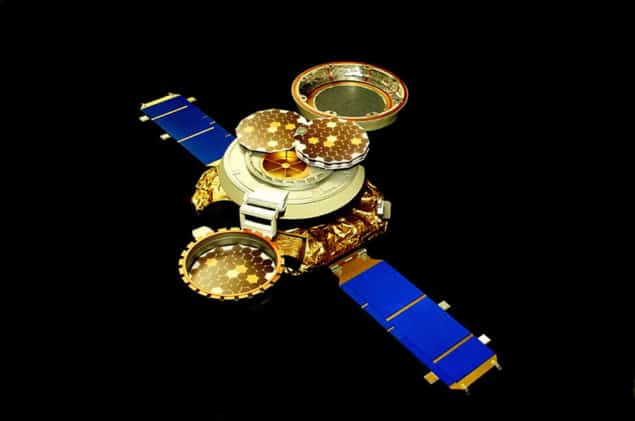
In 2004 NASA’s Genesis space mission made an unplanned crash landing, damaging its precious cargo of solar-wind particles. Now, after years of painstaking work, two independent groups of scientists have managed to measure the relative abundances of nitrogen and oxygen isotopes in the solar wind. Their studies reveal that the isotopic compositions on Earth are very different from the Sun. The result could prove important to understanding the conditions in the early solar system, when the Earth was forming.
While scientists know a great deal about the isotopic abundance of elements on the Earth, Moon and meteorites, very little is known about the Sun. Fortunately, the Sun spews out a steady stream of ions called the solar wind, which can be captured by spacecraft. Although mostly hydrogen, the wind does contain small amounts of heavier elements and their isotopic composition is believed to be similar to the material from which the solar system formed.
Focusing the wind
Genesis collected the particles over about two years using a solar-wind concentrator, which uses electric fields to accelerate the oxygen and nitrogen ions and focus them on a number of ultra-pure silicon-carbide targets. Despite boosting the number of ions hitting the targets by a factor of 20, the concentrations of the isotopes in the targets was still very small when the mission returned to Earth and would therefore require careful analysis.
But tragedy struck in 2004 when the mission’s sample-return capsule failed to deploy its parachute as it fell towards Earth. The capsule overheated and smashed into the ground, breaking open and shattering much of its contents, including many of the solar-wind targets.
What remained of the targets was contaminated by a range of materials (including a mysterious oily film) and scientists embarked on a painstaking process to clean the samples. This cleaning was difficult because the oxygen and nitrogen ions reside about 100 nm below the surface of the targets and could easily be scrubbed away.
Scanning the surface
Now, the silicon carbide targets have been cleaned sufficiently to have their oxygen and nitrogen contents analysed. One study has been undertaken by Kevin McKeegan and colleagues at the University of California, Los Angeles and other universities in the US, UK and Japan. They used an instrument specially designed for Genesis called MegaSIMS, which is a secondary ion mass spectrometer coupled to an accelerator mass spectrometer. An important feature of the instrument is that it can analyse tiny regions of the sample about 2 µm across in order to find regions of the surface that are not contaminated.
The team measured the abundances of oxygen-17, oxygen-18 and oxygen-16 in the samples. They found that the ratios of oxygen-17 to oxygen-18 are the same in the Sun and on Earth. However, they found that oxygen-16 is about 7% more abundant in the Sun than on Earth.
“We found that the Earth, the Moon, as well as Martian and other meteorites which are samples of asteroids, have a lower concentration of O-16 than the Sun,” said McKeegan. “The implication is that we did not form out of the same solar nebula materials that created the sun – just how and why remains to be discovered,” he added.
Cleaned with ions
Meanwhile, Bernard Marty and colleagues at the University of Nancy, France and several US institutions used a secondary ion mass spectrometer to measure the ratio of nitrogen-15 to nitrogen-14 in the solar wind. A target from Genesis was placed in the instrument and its surface was first cleaned using a low-energy beam of ions. Then the isotope concentration was measured as a function of depth in several regions about 10 µm in diameter.
The concentrations of the nitrogen isotopes peaked at about 80 nm into the target, which the team says is consistent with how Genesis captured the solar wind. The researchers found that the ratio of nitrogen-15 to nitrogen-14 is about 40% smaller in the solar wind than it is in Earth’s atmosphere.
Robert Clayton of the University of Chicago, who was not involved in either study, believes that the oxygen and nitrogen differences could be a result of the interaction of sunlight and the cloud of gas molecules present in the early solar system. This process is called photolysis and results in carbon monoxide and molecular nitrogen separating into their constituent atoms.
Opaque gas cloud
The precise wavelength of light required to break down a molecule depends on its isotopic composition, explains Clayton. It turns out that the light needed to break down carbon monoxide molecules made from oxygen-16 does not travel very far through a gas cloud. This means that the interior of the cloud will contain enhanced concentrations of atomic oxygen-17 and oxygen-18. These liberated atoms take part in the chemical reactions that led to the formation of mineral dust that eventually became Earth and the inner planets. A similar process would also enhance the amount of nitrogen-15 in the dust, according to Clayton.
Clayton points out that the relative abundance of the nitrogen isotopes on Jupiter is similar to that of the solar wind, suggesting that isotope separation by photolysis only occurred in the inner solar system.
The research is described in two papers in Science.



